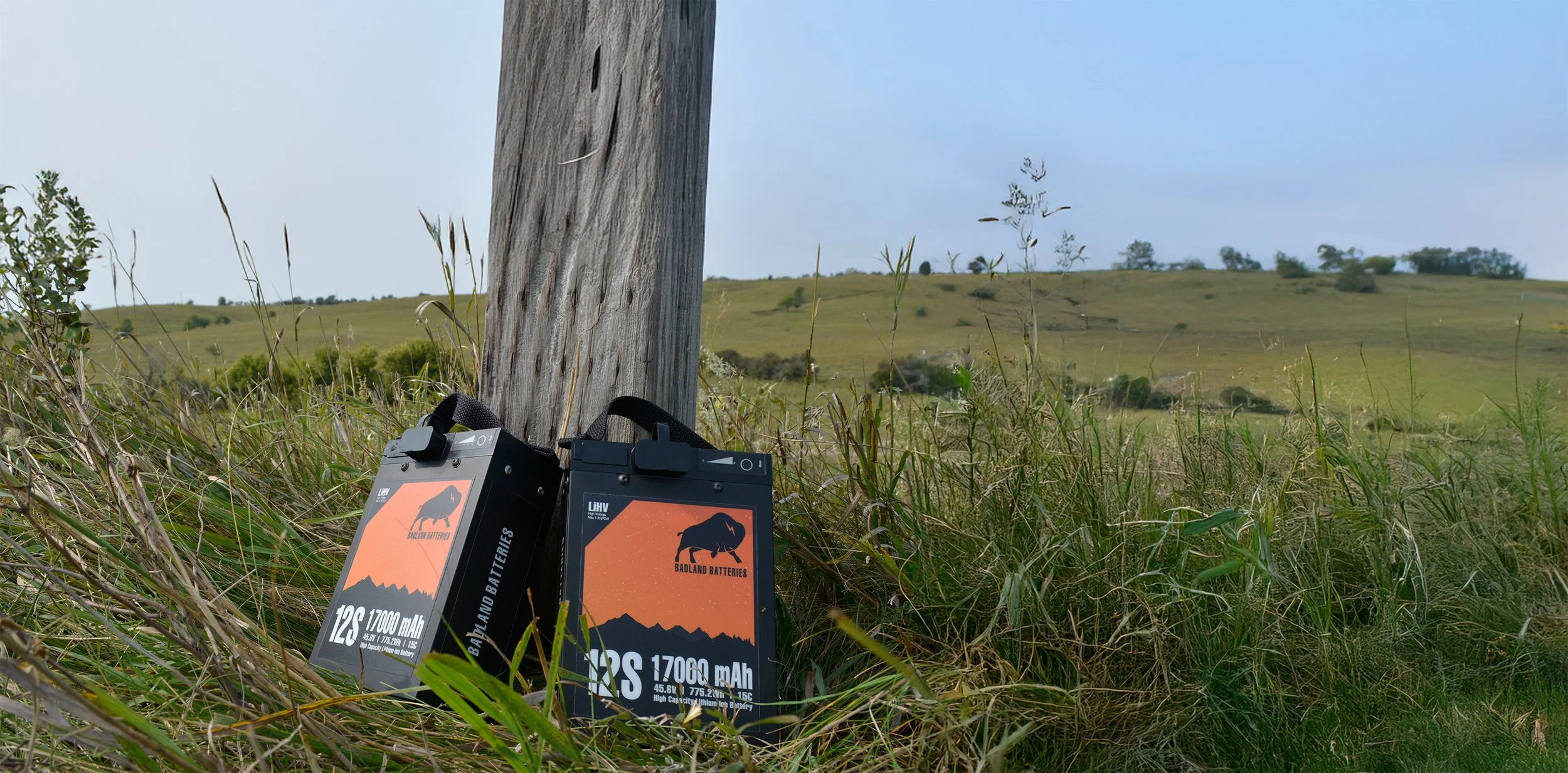
Why Badland?
The engineers at Badland Batteries are experts in manufacturing high-performance batteries for your UAS needs. Those same engineers have years of experience making batteries for some of the most prestigious entities in the world and can now bring that quality to you.
Badland Batteries are designed, assembled, tested and supported in Fargo, ND, giving you peace of mind knowing the process starts and ends in the same facility with the same team. Our batteries are NDAA compliant and combine high performance with lower cost across multiple formats.

Badland Batteries Available Now
Built in Fargo, North Dakota, by the Packet Digital team, Badland Batteries are designed specifically for UAS platforms. Our team has years of experience building drone batteries and charging systems for the toughest clients in the world, and with Badland, we’re bringing that experience to you.
Accuracy
Provides accurate state of charge information and power warnings to your UAS so you know how much charge you have left. This lets you reduce the margin to fly longer missions or use a smaller battery
Energy efficient
A patented algorithm extends the battery’s life and returns better ROI. Tether multiple batteries for even longer flight times and larger payloads. PX4 and Ardupilot support for telemetry. NDAA compliant
Storage
Badland Batteries are built with high quality, high energy density cells that automatically self-discharge during extended storage periods dramatically increases the battery’s life
Maintenance
Monitoring and reporting faults helps you stay safe. Critical lifetime usage and health information is stored. Visible state of charge that is accurate within 1% compared to the 5-10% industry standard
Safety features
Over-voltage, under-voltage, over-temperature and under-temperature protection are featured, as well as de-energizing outputs and battery cell temperature monitoring
American manufactured
With a manufacturing facility in Fargo, North Dakota, Badland Batteries are designed, assembled, tested and supported in the United States with globally sourced parts.
What are important considerations when choosing a battery?
-
C-rate is a measurement of how fast a battery is charged or discharged relative to its capacity. It tells you the current (in amps) at which the battery is charged or discharged. So a 10,000mAh battery can supply 10A of current for 1 hour, theoretically.
To determine what C rating you require, you’ll need to compare your continuous current needs to the battery’s capacity. So if you need 100A and your pack is 10Ah, you’ll need cells rated for 10C continuous discharge at minimum.
-
S is series and P is parallel. Series raises voltage and parallel raises amp-hour capacity. So 6S1P would mean you have six cells in series, 1 in parallel for a total of six cells in the pack.
-
There is a tradeoff between power and energy density that can be compensated for with added cost. High power cells and high energy cells can be made relatively cheaply, but high power cells that are also high energy require complex, expensive design. It’s important to look at the continuous C rating of the cells and consider that higher voltages might make the whole system more efficient.
When looking at the C rating, make sure to consider that there is a pulse rating and a continuous rating. Generally anything over 10 seconds is considered continuous so if your peak current happens at takeoff or landing, you need to spec your pack based on that.
-
Smart batteries have an active battery management system onboard that will monitor cell voltages and temperatures to prevent overcharging and over discharging, as well as cell balancing and limit peak current to protect the battery and its electronics.
-
Cycle life of a pack is worse than that of the cells that it comprises. The weakest link determines the fate of the pack. So looking at average cycle life of cells isn’t directly useful in estimating your pack cycle life.
Pack cycle life may be 50% or even worse due to variation in cells and thermal and electrical imbalance in the pack design. If you have a target pack cycle life in mind, make sure to investigate what that means when compared to the cell cycle life because they are not the same.
-
You can increase voltage by adding cells in series. The tradeoff is that for the same weight of battery, you’ll have lower amp-hour capacity, but higher voltage and the same amount of energy. The benefit is that at higher voltages you can draw less current for the same amount of power. This is good because efficiency is inversely proportional to current, so we increase system efficiency by raising voltage.
However, higher voltage does come with costs. High-voltage electronics tend to cost more, so ultimately voltage tends to scale with vehicle size.
-
Energy density is simply the energy capacity (voltage * amp-hour capacity) of the pack divided by the weight. The energy of the pack is proportional to your endurance and the weight of the pack is also, inversely, proportional.
Energy density includes the weight of the enclosure, wires, connectors, BMS, and other packaging materials, and results in a somewhat lower energy density than you would see at the cell level.
-
Generally speaking, yes. Unless you’re discharging so quickly that cooling won’t come into play, maybe 2-5 minutes flight time, cooling can make an important difference in system performance.
High-energy cells typically produce more heat and efficient cooling means you can keep cells at optimal temperatures improving cycle life and flight duration.
-
Because a battery manufacturer is based in the United States doesn’t mean it’s NDAA compliant or that the majority of its materials and components are sourced within the country. At Badland Batteries we take every measure possible to source our materials and components inside the United States.
-
Absolutely, yes. UN38.3 certification is required for shipping lithium batteries. The testing includes: Altitude, Thermal, Vibration, Shock, External Short Circuit, Overcharge, Impact/Crush and Forced Discharge. Passing is vital to ensuring batteries are safe to transport and upon receipt will operate as advertised.
However, some companies self certify their batteries. Badland Batteries does not and utilizes a third party to test our packs. No corners are cut by our team.

We love talking batteries and how our power solutions are the best option for your UAS setup. Reach out today to talk with one of our battery experts!






